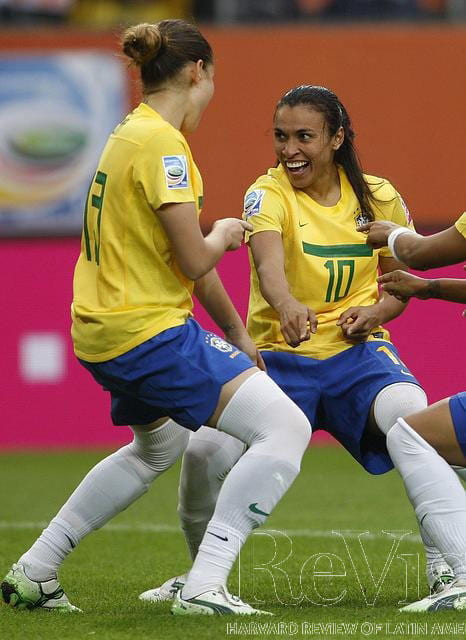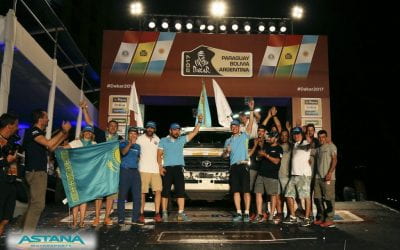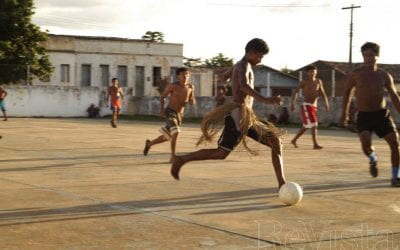“No one knows, no one saw,” reads the headline in an important Brazilian newspaper announcing the conclusion of the main women’s soccer championship on the continent—the Taça Libertadores da América—accompanied by a photograph of an empty stadium. The team from Santos won the Cup for the second time with six victories in six matches, scoring 25 goals and suffering none. Brazil’s national champions dominated the other teams, even Chile’s Everton and Argentina’s Boca Juniors. The tournament finished with an average audience of 300 people per game, in other words, all of the games were played in nearly empty stadiums.
By comparison, the men’s D Series championship (the fourth from the top in the country) averaged 2,700 paying viewers per game, nine times as many.
The paucity of fans can be interpreted as a lack of interest in women’s soccer in Brazil, a sport which is new in the country. But in 2009, 15,000 people went to Pacaembú Stadium to watch the final of the women’s Liberators Cup, largely because the game was broadcast on television and Marta was playing for Santos.
Marta Vieira da Silva, or simply Marta, is a midfielder who has played for Sweden’s Umeå IK, Santos, L.A. Sol, FC Gold Pride and Western New York Flash and was a member of the Brazilian national team that won the silver medal at the 2004 and 2008 Summer Olympics. Marta was voted FIFA’s Women’s World Player four times. During the 2009 final, the fans chanted, “Marta is better than Kaká,” referring to Brazil’s internationally famous male star. Still, her fame does not compare to that of male players.
Santos was not able to hire Marta in 2010 because of the higher salary ($400,000-$500,000 annually) she commands at the L.A. Sol. Without Marta on the field, games were only broadcast on pay television.
The way the few television broadcasts narrate women’s games points out the great gap between men’s and women’s soccer. The players are regularly characterized with formulas such as “Cristiane, who is on the Brazilian national team,” and the recent history of women’s soccer needs to be explained—“women’s soccer became an Olympic Sport in 1996, when Brazil was in fourth place.” It is difficult to imagine having to inform viewers of men’s soccer that Maycon, Robinho or Neymar is on the Brazilian national team or that Brazil is a five-time world champion.
In 2010, the press barely covered the women’s Liberators Cup, preferring to use the space for the coverage of unimportant international matches of the “seleção,” the Brazilian national team, and the national league in male soccer. A study conducted of the leading Brazilian news magazines, Época, Isto and Veja, and the leading sports magazine, Placar, showed that in the past four years there were only 11 articles about women’s soccer (Almeida, Caroline. Boas de Bola. Projeto de dissertação. PPGAS/UFSC, 2011). In other sports, differences exist in coverage between genders, but not nearly as sharp as those in soccer.
A bit of history
When soccer came to Brazil from Europe in the mid-19th century, it did not totally exclude a female presence. In fact, the name that designates a fan in Brazil, torcedor, comes from women squeezing white handkerchiefs (torcer in Portuguese) at the peak of their demonstration of passion for one of the teams. The throng of women at the games was encouraged as a form of sociability between the genders, creating another location to meet a “good partner,” a white husband from the elite. The women were there to make the location more attractive, not to learn to play a new sport.
As workers gradually took up the space previously reserved for aristocrats on the teams, women also shifted their role from fans to players. These transitions met with strong resistance, strongest and longer-lasting against women’s soccer. In men’s soccer, professionalism was once prohibited as an indirect way to exclude the lower classes, and blacks and mulattos were not allowed on the teams. These interdictions died at the beginning of the 20th century with the gradual inclusion of blacks on the teams and the institution of the so-called “brown amateurism” in which players were paid on the side (Mario Filho, O Negro no Futebol Brasileiro. RJ: Mauad, 2003).
Historians differ about the date of the first women’s soccer game played in Brazil. For the first decades of the 20th century, there are records of women’s teams playing soccer in São Paulo and Rio de Janeiro. Historian Fábio Franzini, in the article “Futebol é coisa ‘para macho’?” points to the existence of at least 10 women’s teams, including Cassino Realiengo and the Eva Futebol Clube, competing in tournaments in Rio de Janeiro by the 1940s, when Brazil was under the control of dictator Getúlio Vargas.
The number of women’s soccer teams increased with time, according to Franzini, and reached about 40 in Rio de Janeiro in the mid-1940s. But then women’s soccer suffered a tremendous blow, with a ban that would last decades.
A letter from a Mr. José Fuzeira to President Vargas, which helped trigger the law, asks for “the clairvoyant attention of your Honor to avoid a calamity that is about to fall upon female youth in Brazil.” He explained:
“I refer, Mr. President, to the enthusiastic movement that is inspiring hundreds of girls, attracting them to become soccer players, without considering that a woman cannot practice this violent sport without seriously affecting the physiological equilibrium of her organic functions, due to the nature that disposes her to be a mother… The newspapers say that in Rio there are nothing less than ten women’s teams. In São Paulo and Belo Horizonte others are being formed. And, with this growth, within a year it is probable that throughout Brazil there will be 200 organized women’s soccer clubs, or, in other words, 200 centers to destroy the health of 2,200 future mothers, who, moreover, will be caught in a depressive mentality and given to rude and extravagant exhibitions… It would not be surprising that the feminine movement to which we are referring is just a beginning, for, over time, the daughters of Eve will also present themselves in wrestling matches and even in the “noble art” whose nobility consists of two opponents hitting each other until they drool blood (Franzini, Fábio, “Futebol é ‘coisa pra macho’? Pequeno esboço para uma história das mulheres no país do futebol.” Revista Brasileira de História. n. 50, vol. 25. São Paulo. 2005. p. 316 – 328).
Vargas gave heed to the clamor for maintaining male domination over women’s bodies by pretending to protect their maternal functions, and forwarded the letter to the Minister of Education and Health, who, in turn, corroborated the writer’s thesis, raising scientific and medical arguments that supported the drafting of article 54 of the decree of April 14, 1941 by the National Sports Council, stating that “Women will not be allowed to practice sports incompatible with the conditions of their nature, and for this reason, the National Sports Council should issue the necessary instructions to sports entities in the country.”
The medical reports that supported excluding women from soccer sought to protect their procreative capacities, which would supposedly be placed at risk. The argument is a corollary to eugenic ideologies influential in the country since the 18th century, which preached the importance of protecting women’s bodies so that they could breed healthy children and thus improve the white race in Brazil. The theory is highly refutable because of the simple fact that women’s reproductive organs are internal, unlike men’s, which are outside the body, objectively at greater risk when playing soccer.
Behind this supposed protection, we find the mise-en-jeux of a biological-social image of woman: that of the mother, conforming to an ideal corporal model of a plump body, without visible muscles, with rounded forms and limited mobility. This model corresponds to socially prescribed feminine behavior: passive and submissive, without agency.
The long exclusion
Prohibited since the 1940s, women’s soccer continued to exist in the shape of sporadic transgressions against the order of male domination. Luiz Carlos Rigo’s article, “Notas acerca do futebol feminino pelotense em 1950: um estudo genealógico” [Notes on Women’s Soccer in Pelotas in 1950: a genealogical study], documents the organization of two women’s soccer teams in the city of Pelotas in southern Brazil, the Vila Hilda F.C. and the Corinthians F.C., which challenged the legislation and functioned until banned by the Regional Sports Council. Most of the players were young, ages 13-18, came from the lower middle class, and lived in the neighborhoods where the clubs were located. Some of the athletes stood out, such as the striker Gelsi, described in a local newspaper as an “element of great quality,” who “controls the ball with precision, with the opportunity to translate her qualities as the playmaker of the Sunday match.” The respect offered in this brief newspaper article, however, was not enough to change the position of sporting authorities, and, unfortunately, the teams had short lives.
There were other cases similar to those in Pelotas, but only a few, and when they gained notoriety they were systematically stopped by the Regional Sports Councils. What is surprising is precisely the rarity of the transgressions.
The 1941 law remained in force and was affirmed by the military dictatorship in 1965. Thus during the 1970s, a time of great transformation in gender relations in the Western world, Brazil reinforced the exclusion of women from the sport that occupied (and still occupies) a central place in the Brazilian imagination. Banning women from soccer, which articulated nationalism and modernity, excluded them from a greater collective and a broad spectrum of social practices. Incapable of symbolically representing the nation, they were not only passive, silent and submissive, but also second-class citizens. To keep them from playing soccer was to exclude them from full participation in the nation.
The prohibition of women in Brazilian soccer was revoked in 1979, after the country’s political opening, following heated debates in the field of physical education which were stimulated by the feminist movement. In the same year, an Amnesty Law was passed which allowed the return to the country of women who fought the dictatorship and went into exile, mostly in France. The feminism that began during the 1970s and was linked to the struggle against the dictatorship raised questions at the end of the decade related to the body and to sexual and reproductive rights (Grossi, Miriam P. 1996. “Feminismes et Generations Politiques des Années 90 au Brésil.” Cahiers du Cedref (Politique et Recherchees Feministes), Paris, v. 6, p. 169-190). In the end feminists linked to the field of physical education gained a great victory: the end of the prohibition of women’s participation in soccer (and in other sports) as spelled out in Deliberation no.10 of the National Sports Council.
Marta and the exception that is the rule.
According to Fábio Franzini in his 2005 article “Futebol é ‘coisa para macho’? Pequeno esboço para uma história das mulheres no país do futebol,” various women’s soccer teams sprung up around the country beginning in the 1980s, linked to both traditional clubs and independent businesses, with games in the 1970s organized by gay bars, if we believe a Vejamagazine report. The National Sports Council maintained ridiculous rules for bodily protection such as breast shields and shorter game time. Women’s soccer began to organize local and regional competitions, but the first Brazilian championship wasn’t held until 1994.
The re-initiation was led by Radar in Rio de Janeiro, which had the leading athletes. While Radar enjoyed a series of victories in international competitions, it was only with the Olympic Games of 1996 that we can speak of a significant return of Brazilian women to the soccer fields.
Despite the strong performance of Brazilian women in international competitions, activity within the country is far below that in other countries. Although gender relations have been transformed in recent decades, the famous line of the former coach of the Brazilian men’s team, João Saldanha, still rings true for most Brazilian men: “Can you imagine your son coming home with his girlfriend saying: ‘she’s the defender for Bangú’? No way, huh.”
The women who enter the universe of soccer must be capable of attracting male eyes not because of their athletic performance, but for their quite specific physical attributes. Without any embarrassment, the São Paulo Soccer Federation indicated that “feminine” beauty is a fundamental requirement for selecting the girls who would play in the competition. In the words of Federation President Eduardo Farah, “We have to try to combine the image of soccer and femininity.” Another director of the FPF, Renato Duprat, was even more categorical: “No one plays here with short hair. It’s in the regulations” (Arruda, Eduardo, “FPF institui jogadora-objeto no Paulista” at
http://listas.cev.org.br/cevmkt/2001-09/msg00216.html.2001).
Thus, although permitted, women’s soccer continues to be limited by a macho perspective of gender, which only accepts the presence of women on the field by controlling their bodies: now, however, it is not mothers that they want, but sensual models. Those who may think that this view is limited to Brazil have never seen the websites of the most important sports media in the world.
In this situation, the chant “Marta is better than Kaká” truly seems to be an exception. And it’s true: to get where they are, the Martas of Brazil need to overcome much tougher obstacles than the Kakás.
The international circulation of athletes
With limited space in Brazil, few clubs, and poor salaries, some women soccer players have sought other places to play. In Brazil, most professional women players earn about R$500 (200 euros) a month. In the large clubs, the salaries range from R$1,500 to R$5,000 (600-2,000 euros) a month. In the United States, a typical salary among the top players is US$500,000 a year (Frutuoso, Suzane G. “A bola está com elas. O futebol feminino começa a ganhar espaço com salários melhores e campeonatos importantes, como a Libertadores.” Época n. 2082 de 07. Out. 2009). In Sweden, it is estimated that Marta earned about US$8,000 a month.
The export of players to countries in the North has gone on for years. Pretinha, one of the precursors in this movement, played 3 seasons in the United States, and later in Japan. Kátia Cilene and Simone Jatobá went to France, Elaine and Marta went to Sweden and the United States, Cristiane went to Germany, Sweden, and the United States and Rosana to Austria. Of the 11 starters on the Brazilian women’s team, 8 play abroad. But this flow is far less than that of male athletes, and the women obviously do not have the same visibility as the men. The Brazilian Football Federation (CBF), an entity linked to FIFA, has records of the departure from 2004 to 2009 of only 46 women from the country, compared with 3,000 men. The United States led the importation of Brazilian women with 14, followed by Spain with 10.
On November 18, 2010, the main sports program on Brazilian television concluded with a report on two games the night before. Argentina had defeated Brazil 1 to 0 in a friendly in Qatar. In a second light-hearted commentary, the report noted the 4–0 victory of the Brazilian women over Argentina. Nevertheless, unlike the avalanche of images of the men’s defeat, the television showed only a few photos of the women’s victory. It was an official game of the South American championship, which Marta and her colleagues won a few days later. Although theoretically such a match was more important than the friendly, there was no televised transmission, and few images to show. Once again, no one knew, and no one saw.





